There is no doubt that PR outreach can help your project grow – especially if it’s a local business.
The only problem?
That most people are doing it wrong.
And, with 57% of top-tier publishers receiving between 50 and 500 pitches per week, you can see why most pitches never get read.
In this guide, you’ll learn what PR outreach is and how to do it the right way, as well as get a list of the best tips and tools concerning this topic.
Let’s get started.
Link building cheat sheet
What is PR Outreach?
Digital PR outreach is the process of promoting (pitching) information about your products and services to journalists, bloggers and people with influence in your industry, with the purpose of getting press coverage, brand mentions and extra online presence for your business.
As we mentioned in a previous post, nowadays, when we’re talking about PR outreach, we mostly refer to digital rather than traditional PR.
Of course, while the purpose is the same—getting more exposure and raising awareness about your products and services—it’s the medium and process that have changed.
Oh, and also reputation management in times where crisis communication becomes a priority.
In the past, the media outreach plan of most companies would aim to get 1-2 minutes of air time on a TV show.
Nowadays, the aim is to get featured in a large media publication such as TechCrunch.
For example, in December 2019, dating app Blindlee got press coverage via TechCrunch.
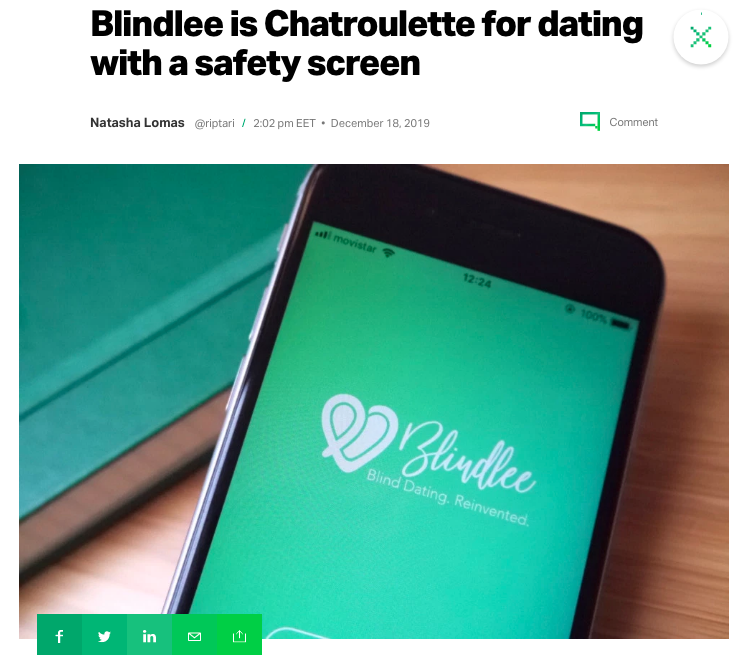
This created a domino effect for Blindlee, since after the TechCrunch article, many other related articles in popular publications followed.
Also, around that time (December 2019), we can see a spike in Google Trends for the interest in the term “Blindlee”.
Note: Blindlee used Respona for this public relations outreach campaign.

This shows us that an article on TechCrunch is able to raise awareness for a company and also generate interest for its products and services.
Interestingly enough, other companies report similar results when they pitched and got featured within similar publications like Forbes, Mashable or Business Insider.
The truth is that, especially for a new product, getting press coverage like the one I just mentioned can cause a significant uplift in signups and boost its bottom line.
The question, of course, is: how can you get featured in those types of media outlets?
What most people seem to forget when they’re going after a press release or brand mention of that kind is that the game relies heavily on building relationships.
You simply can’t pitch to someone who doesn’t know you—and most likely doesn’t care about what you have to say—and expect to get press coverage or a mention on that person’s blog.
Some of the things you stand to achieve through email outreach are:
- Your business gets mentioned
- You get backlinks from high-authority sites or blogs
- You get featured as a guest on industry-specific podcasts and shows
- You get to publish your own guest post in popular publications and on media sites
Of course, the goal of your PR efforts will determine the audience you need to reach and the way you can reach them.
For example, if you’re aiming to build links, you’ll have to adjust your PR outreach email accordingly, just as Brian Dean from Backlinko did with the following pitch:
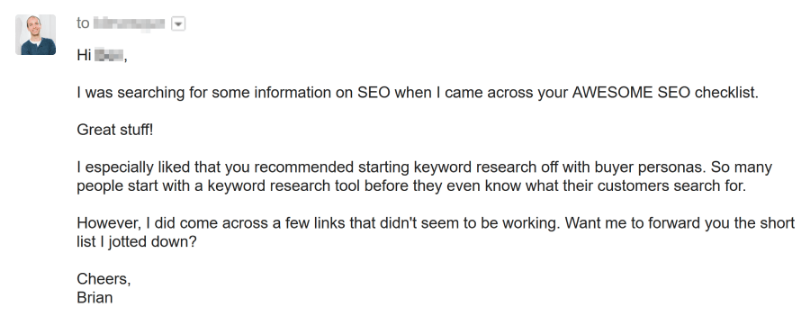
The goal here is to acquire a new link, based on a broken link on the prospect’s site.
Thus, the copy and tone of the message are adjusted accordingly.
In another example, Rich Edwards—who was trying to promote an infographic he published on his website—sent the following pitch to several tech journalists:
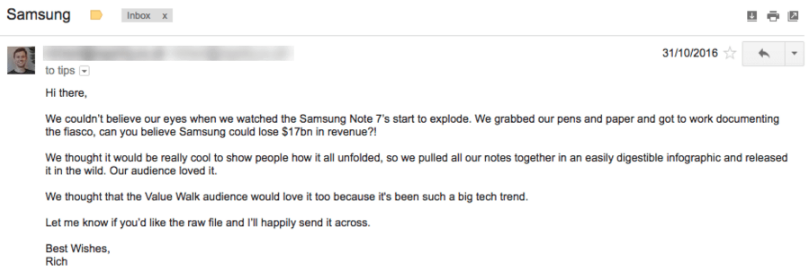
As you can see, the email is tailored to the needs of this specific PR outreach campaign.
All I’m trying to say here is that there are different types of PR outreach that have different objectives, and in many cases require a significantly different process.
It’s therefore essential that you define your goals and objectives early on, so that you know what process you need to follow in order to get there.
In this guide, we’ll cover outreach to journalists and bloggers, with the goal of getting published/featured in popular publications and on blogs and media sites.
How to Find What Journalists & Bloggers to Pitch to & How to Pitch the Right Way
One thing that often goes unnoticed by most PR teams or individuals trying to get their emails through a journalist’s inbox is that they lack a clear prospecting process.
Also, and this is very important, they seem to ignore the fact that PR outreach is all about relationship building and social networking.
In reality, even seasoned entrepreneurs with extensive email marketing experience don’t have much success when it comes to press outreach.
Let’s see how you can beat that by finding the right people to pitch to at the right time.
These are the four steps you should follow:
- Know your target audience
- Gather data about that audience
- Prepare your pitch and get prepared on what to ask
- Reach out to your “PR prospects” and start building relationships
Let’s take a look at these points one by one.
1) Learn your target audience
As you can imagine, the first thing you need to do is to learn about your target audience.
When I say “learn,” I mean that you have to know—since we’re talking about bloggers and journalists:
- Who these people are
- What topics they like to cover
- What publications they write for
- What specific opinions they have on things
Some additional factors that you need to consider are:
- If your target journalists/bloggers like to write about specific platforms (e.g. iOS, Android)
- If they write about specific types of businesses (e.g. enterprises)
- If they are interested in specific types of technology (e.g. artificial intelligence)
- If your prospects seem to be interested in specific problems and their solutions (e.g. global warming)
- If your target journalists like to cover specific platforms (Facebook, Instagram, etc.)
Let’s illustrate this with a simple example.
For the sake of this example, let’s assume you’ve just published an infographic about the popular electric car company, Tesla.
A wise move here would be to find tech writers that are interested in writing for and covering stories around Tesla.
This is exactly what we’re going to do.
Using Respona’s Content Explorer, we’ll conduct a search based on the following criteria:
- Stories and news articles that mention the word “Tesla” inside them
- Stories that were published the last 6 months
- Mainly news stories
First, we need to create a new campaign.
Respona comes with a set of pre-built campaign templates.
For PR purposes, we can use either the news outreach or podcast outreach template.
By using a campaign template, you can pre-configure your search and form the basis for your outreach template, all in one screen.
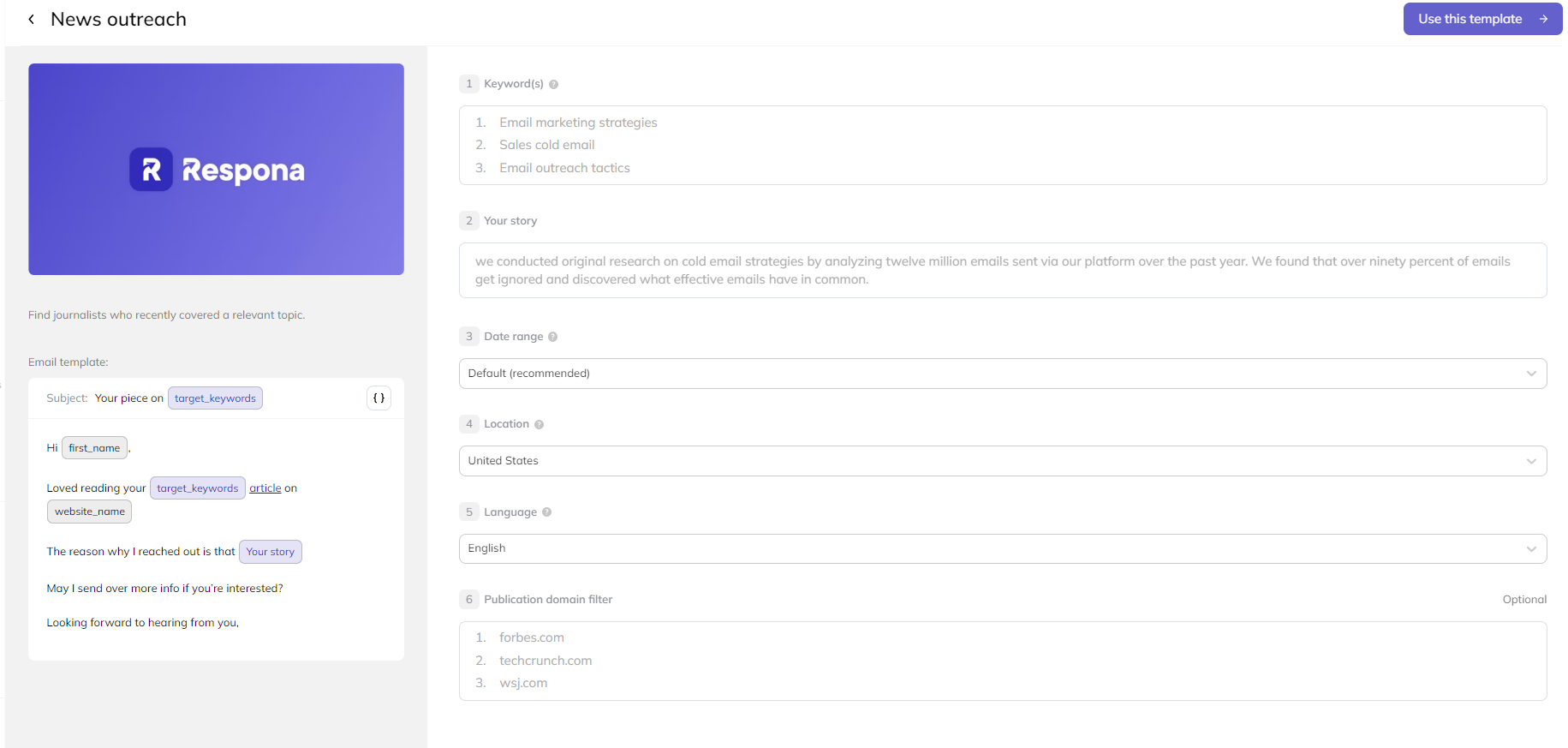
To use it, simply fill out all of the fields.
The news outreach campaign template has two mandatory fields:
- Your target keyword(s)
- A brief summary of your story
The rest are completely optional.
We recommend using the default date range to make sure you’re left with the most recent and relevant journalist opportunities.
Only use the publication domain filter if you want to limit your results to a certain media outlet, such as Forbes and TechCrunch.
After clicking “use this template”, you’ll find that the email sequence is already pre-configured for you:
Since we used a campaign template, we already have an email template outlined for us.
What’s cool about this editor is the fact that it auto-grades your email pitch based on several grading criteria such as spam, word count and subject length.
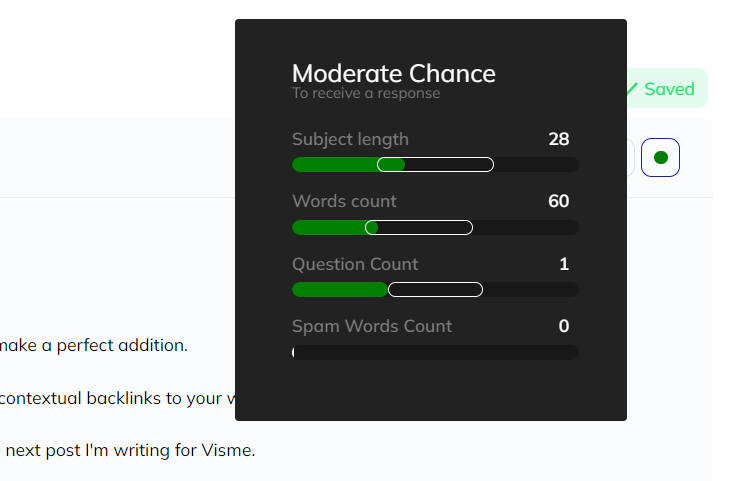
Next, we need to create an email and subject line that will help us get our prospect’s attention.
As we’ll see later on in this guide, our subject line has to be:
- Compelling
- Descriptive
- Non-spammy
So, this is the subject line we’ve come up with:

Note: As you add characters to your subject line, the score on the right changes automatically.
Let’s break down our subject line a bit.
- New: Everyone likes new information about something
- Tesla: Since we know our prospect is passionate about Tesla
- Infographic: We give context as to what the email we’ve sent is all about
- Stats: Stats are linkable, shareable and something anyone can refer to
- 03’ to 19’: Tesla’s founding date was 2003, which means that our infographic contains a lot of data
Now that we’ve finished with our subject line, let’s move on to the next part, which is to create the actual copy of our message.
My advice here is this: Keep it short and sweet.
According to a survey by PR agency Fractl on 1,300 journalists regarding the length of a media pitch:
“More than half of writers and editors across all beats prefer pitches that are between 100 and 200 words.”
So, as you can understand, most reporters and bloggers want to see short pitches that are relevant and to-the-point.
Here’s the one we created for our PR campaign:
Subject: Subject
Hey {first_name},
Read your latest article on {website name}.
We’ve created a new infographic about Tesla’s history so far, starting from their early days in 03′ until 19′ when they announced Cybertruck.
Here are some of the things we include:
- Online brand mentions and fluctuations
- Revenue and profitability metrics
- Employee headcount growth
Would you like to see the final version of the infographic before we have it published?
Let me know and I’ll share the link right away.
Thanks,
And here’s how the email looks in Respona’s editor:
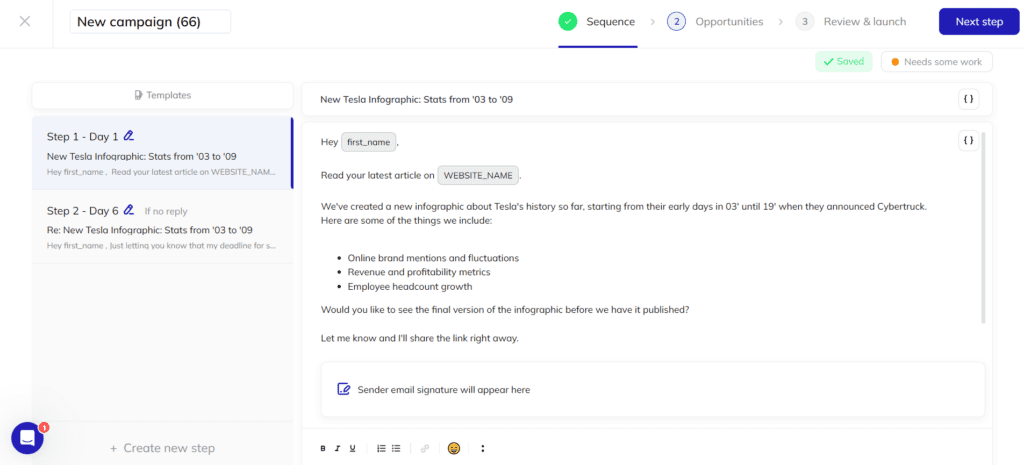
Note: The email hasn’t finished yet, as we’ll personalize it further in later steps.
As you can see, the Score of the email is auto-adjusted as we make changes to our copy.
Right now, our pitch—according to Respona—has a high chance of getting a response.
To insert a variable, all you need to do is click on “Insert Variable” and choose the variable that you want to insert (e.g. First Name or Job Title).
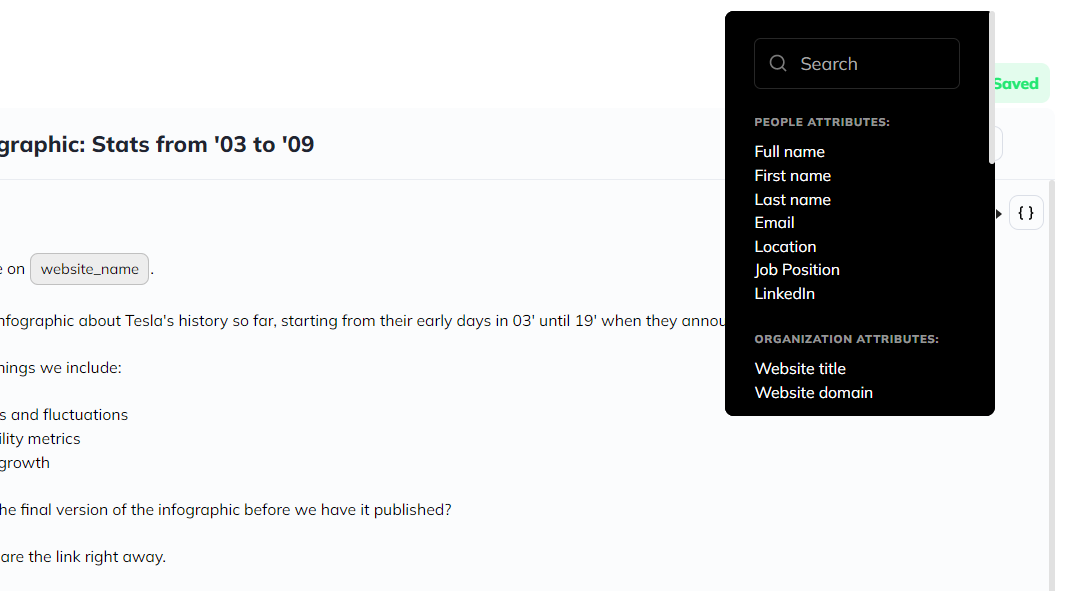
Also, as you might have noticed, the word count is only at 80.
As we’ll see later, journalists prefer short pitches over long ones.
They also want to see specific information on the content we’re trying to pitch.
Our email is short, precise and to the point.
Moreover, by using bullet-points, we make sure to pass on the most “newsworthy” information our asset contains.
Last but not least, we close with a question to get our prospect to commit on a “yes” before we share more information about our infographic.
For this or any other PR campaign, you can add as many follow-ups as you’d like.
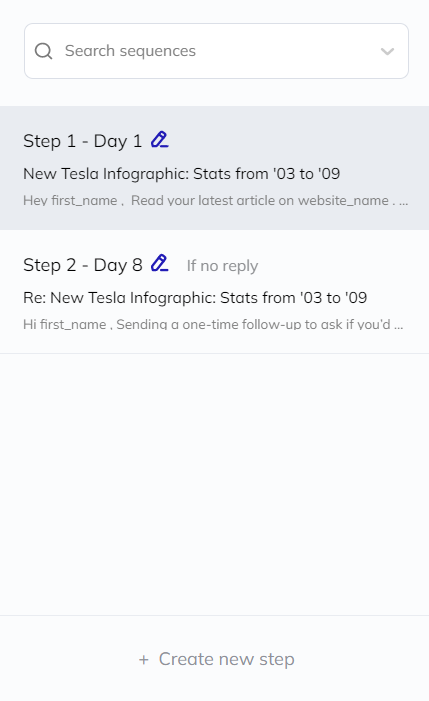
Even though there are some marketing and PR professionals who advise against this approach, we believe that follow-ups can have a positive impact in your campaigns.
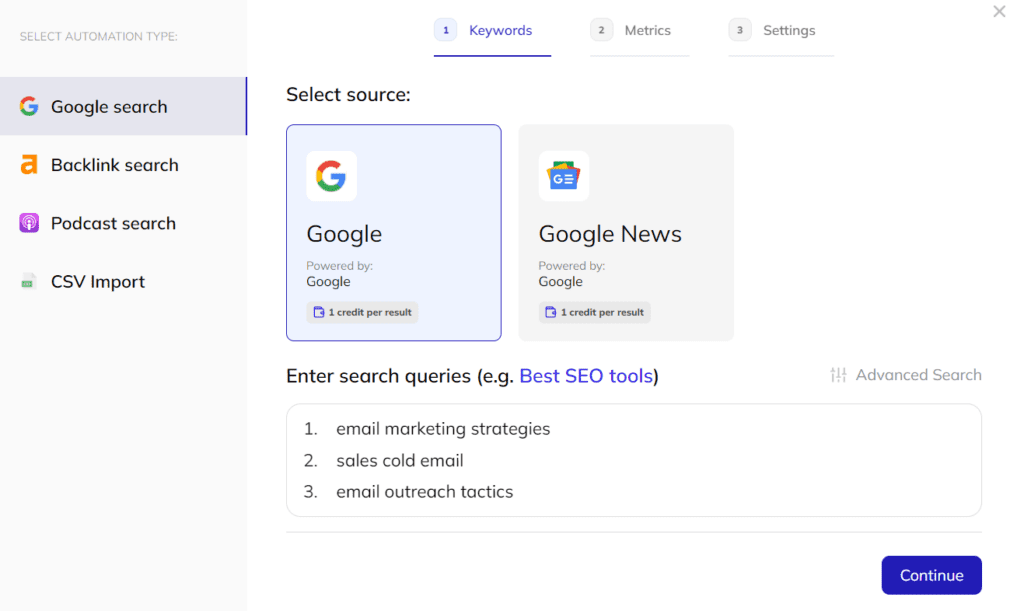
Respona will automatically scrape Google news for relevant articles that mention your target keywords and are published within your specified date range, in your chosen language (English by default), and add them to your outreach campaign.
You may also choose to add additional SEO filters to narrow down your results:
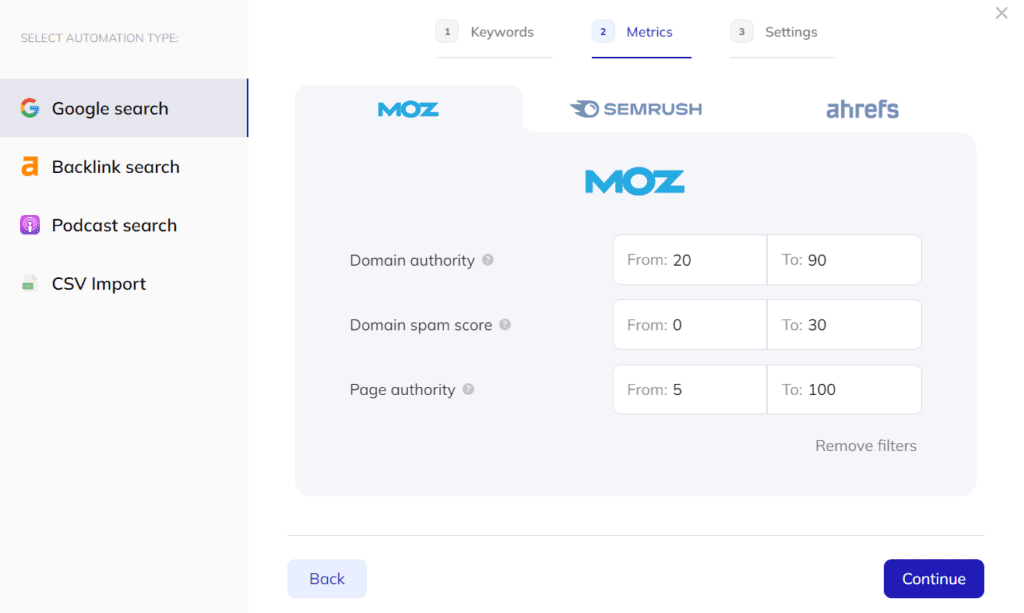
Let’s walk through some advanced settings you’ll see once you click “Continue”:
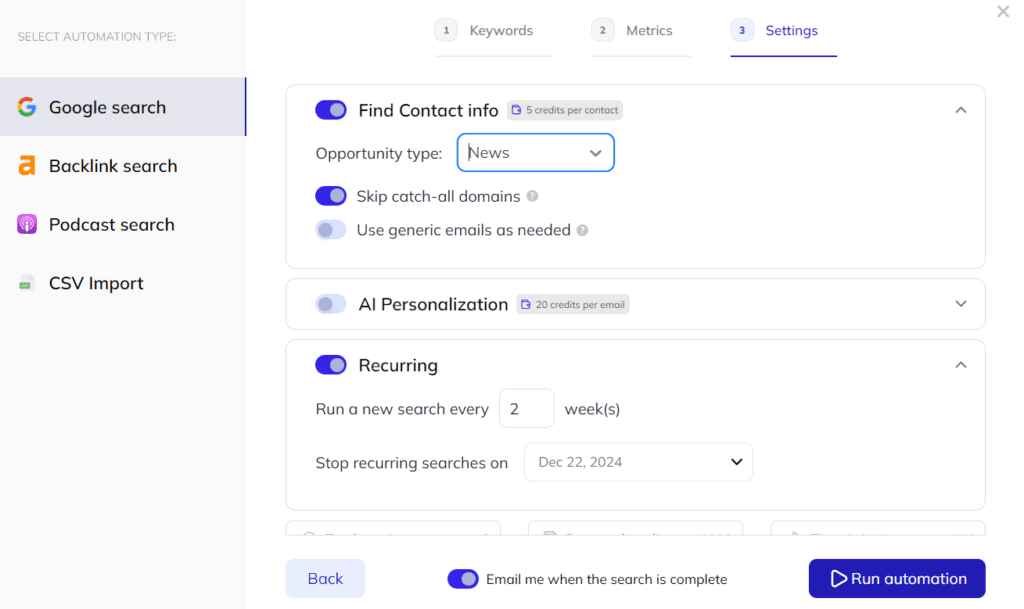
First up, let’s enable a simultaneous media contact search.
Change the opportunity type to “News” and Respona will automatically find contact information of journalists and writers.
Let’s also enable the “Skip catch-all emails” toggle to make sure all contacts we get belong to real journalists and aren’t your generic “[email protected]” address.
Let’s skip AI personalization for this PR strategy because journalist outreach requires a more personal approach.
Last but not least, let’s enable a recurring search every 2 weeks. Respona will automatically re-run it and add relevant opportunities to your campaign, making sure you’re always on top of news articles.
Click “Run automation” and wait for results to be found.

Once they’re found, results will start populating your screen.
Like this article on TechCrunch’s site:

Let’s use TechCrunch’s in-site search to see what other topics this particular PR professional covers.
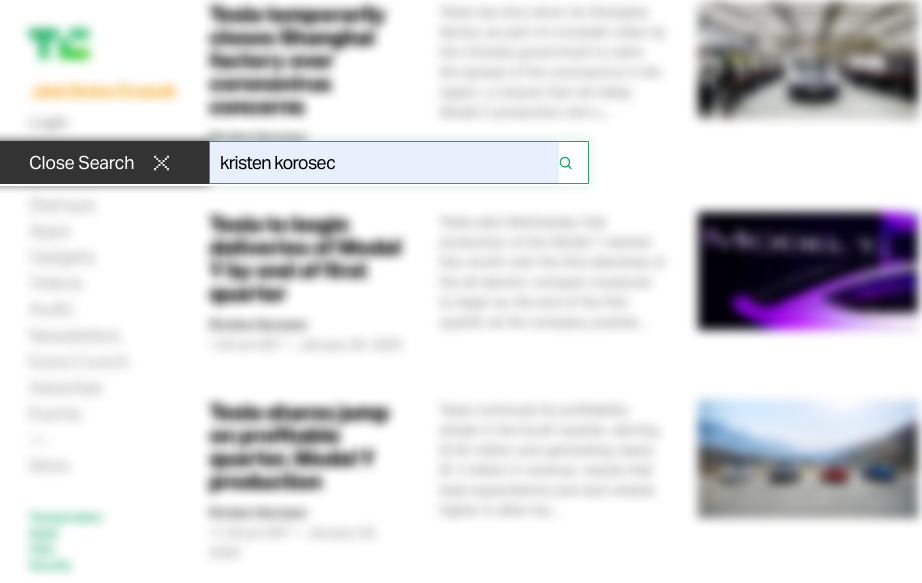
The results you’ll see look like this:
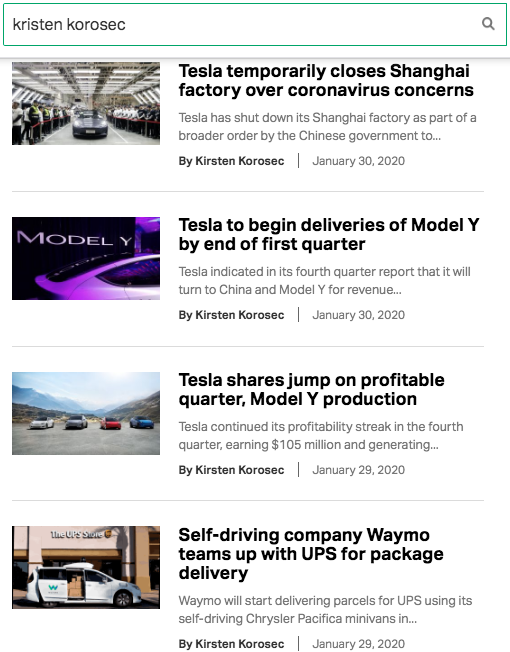
If you click on any of those results, you’ll notice that, once again, it’s a well-researched news article on Tesla or self-driving cars:
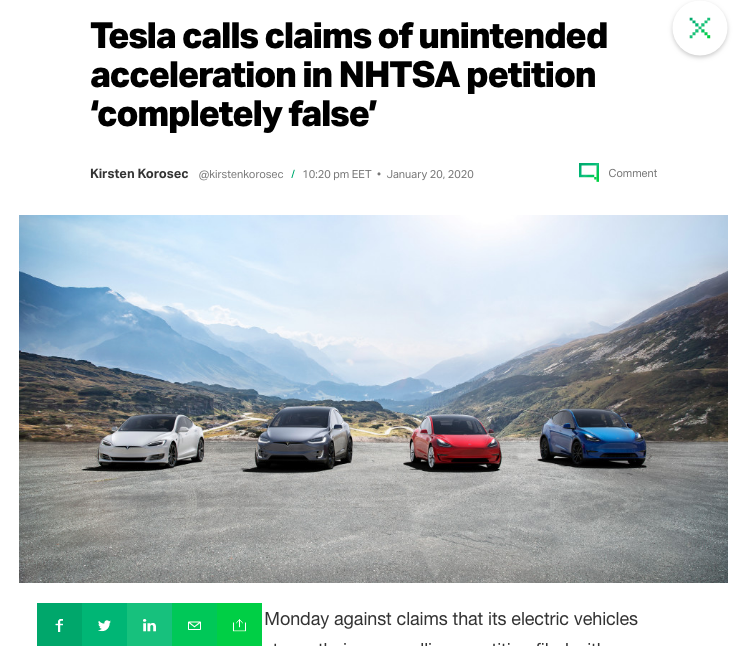
As you can see, some of Kirsten’s most recent articles have to do with Tesla, self-driving cars and transportation in general.
Thus, we could say that Kirsten may be a good opportunity for us to get our Tesla infographic featured on TechCrunch.
Remember: The more (and more relevant) prospects, the higher the chances to get featured on any of those media publications and magazines.
Once we finish with our initial research and come up with a list of articles, we can then move on to the next step of the process.
Next, we have to gather data about our target journalist.
2) Gather data about that audience
Unfortunately, when most people hear about “data gathering”, they usually think of gathering contact information such as a prospect’s phone number or email.
However, the truth is that when it comes to PR outreach—even though we’re also interested in some basic contact information such as the prospect’s email—we’re mostly interested in getting to know our target journalists/bloggers better.
What does that mean exactly?
Back to our Tesla infographic example, let’s try to understand our target journalist, Kirsten Korosec, a bit better.
A logical thing to do here would be to visit the reporter’s Twitter profile.
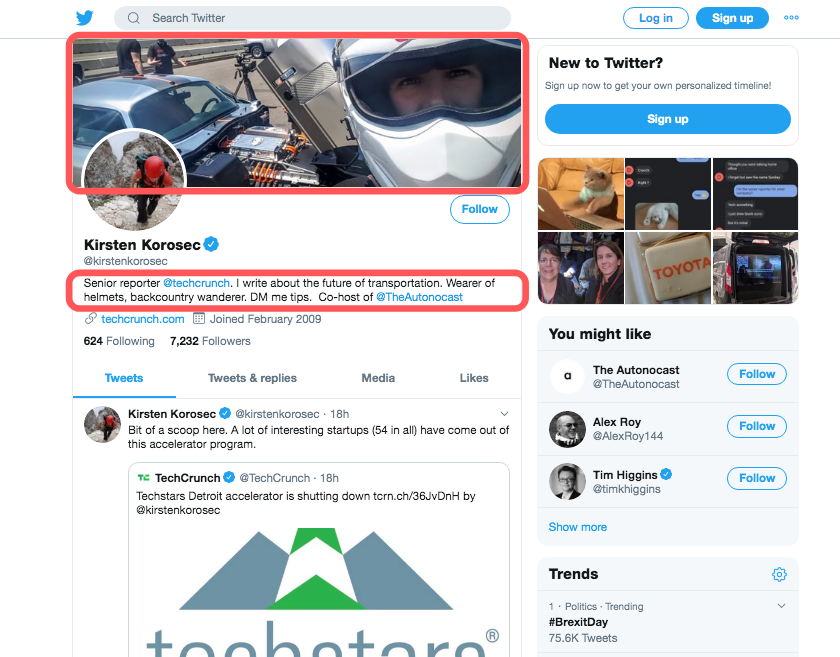
As soon as we do, 1-2 things are instantly obvious.
- The featured image indicates a passion for cars
- “I write about the future of transportation.”—which makes Kirsten the perfect candidate for our PR campaign
- “DM me tips”—Kirsten is actively looking for new content around her passion
- “Co-host of the Autonocast”, a “Podcast about autonomous driving and the future of mobility”
If we scroll down a bit and see Kirsten’s latest Tweets, we’ll also notice that she is passionate about transportation and everything related to that.
The goal here isn’t to read every post that your prospect has posted in the last 5 years.
Instead, it’s to gain a good understanding of what they seem to like, what their preferred way of communication is and what tone they use when posting on social media.
From what we can see here, Kirsten is very involved in everything related to mobility and autonomous driving—and, as an extension, about Tesla.
Note: You then have to repeat that process for the rest of the prospects you have in your list (AKA media list or outreach list).
The better you understand these prospects, the more likely you’ll get a response—and the more likely you are to get a response, the more likely you’ll see your Tesla infographic featured in one of their next articles.
Of course, this isn’t enough, as we actually have to find our prospects’ email so that we can get in touch with them.
How can you do that?
Enter: Respona
We will find the emails and assign each contact with an email later on in the process, as we first have to prepare our email pitch.
3) Reach out to your “PR prospects” and start building relationships
The last part of the process requires you to actually start reaching out to your PR and media prospects and start building relationships.
One thing that we advise Respona users is to always connect with their prospects—at least where possible—on social media before they send an email.
The reason for this is simple:
In the same way salespeople create rapport with their prospects while trying to close the sale, you need to connect and establish a relationship before sending a pitch.
You have to keep in mind that bloggers and journalists are busy people.
On top of that, they receive many cold emails every week—as we mentioned in the beginning, 57% of top-tier publishers receive between 50 and 500 pitches per week.
The last thing they want is to waste time on irrelevant pitches.
This is why you have to follow a more human-first approach and try to play the game by their own rules.
Once you’ve connected with your prospects on social media, you can then launch your PR campaign.
To do that with Respona, you can actually click on the LinkedIn button on each of the contacts you’ve asked to get contact information for…
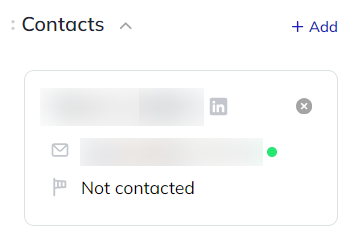
… And connect with that person on LinkedIn by sending a nice, gentle and personalized connection note.
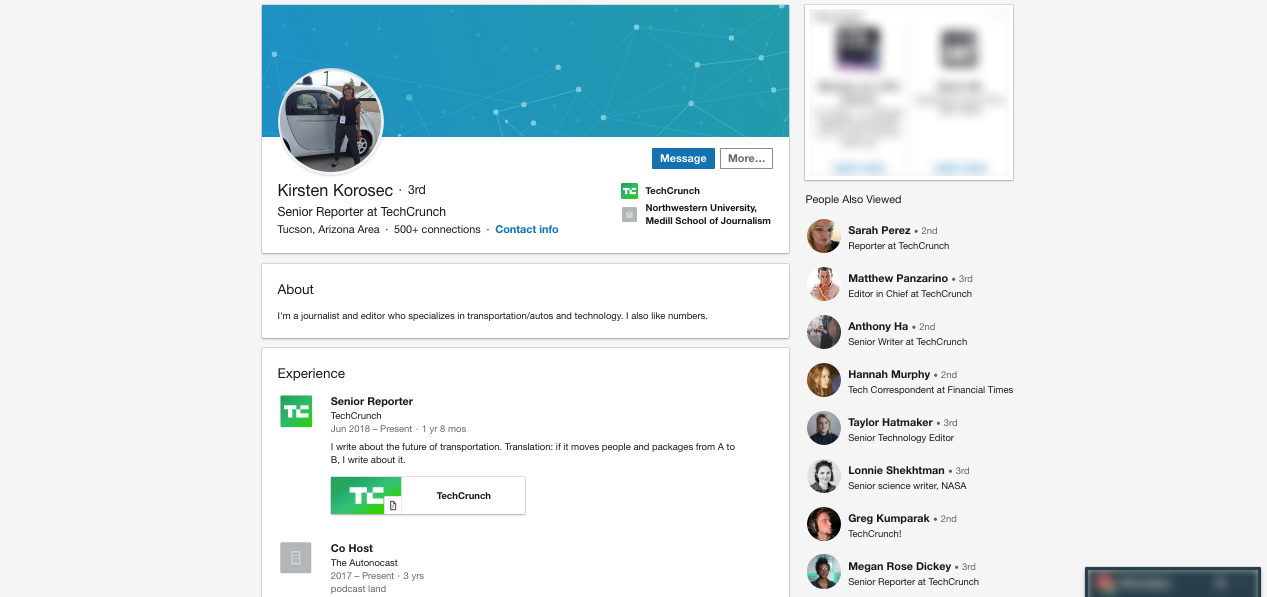
What’s necessary to understand here is that just because this process happens digitally, it doesn’t mean you don’t have to be a human.
Humans want to connect with and establish relationships with other humans, so before you send a pitch, make sure to connect and show some appreciation of the other person’s work and content first.
Let’s move on and see some general tips for successful PR outreach.
Tips for Successful PR Outreach
Even though you now know what makes a good pitch, I’ll provide you with some additional tips you can use when reaching out to bloggers and journalists in the hopes of getting a brand mention or your content featured within a large publication.
Keep in mind that these are just tips—you can use them as principles, but that doesn’t mean you can’t try a different approach.
Let’s take a look at the six tips I have for you.
1) Keep your pitch short
According to a survey by Fractl to 1,300 media publishers, a short email pitch has a greater chance of getting through.
“How short?” you may ask.
According to the responses that Fractl got..
“More than half of writers and editors across all beats prefer pitches that are between 100 and 200 words.”
Thus, as you can understand, keeping your pitch short is essential if you want to get your prospect journalist or blogger interested in learning more about what you have to say.
This is why at Respona, while you’re creating your message (or email sequence), we grade your pitch based on word count.
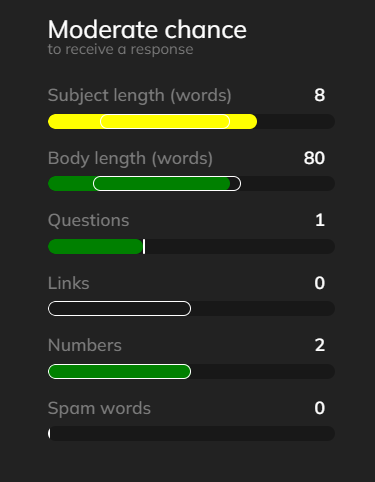
So, make sure to keep your pitch short and sweet.
2) Create a great subject line
What’s the purpose of a subject line?
To get the person receiving your email interested in what’s inside.
Once your prospect opens your email, you then have a higher chance of getting them to actually read the body text of the email.
According to the survey by Fractl that we just mentioned, “sixty-six percent of publishers agree that an email’s subject line is the most important factor for whether they open an email.”
Thus, you can understand that when it comes to your email’s subject line, the stakes are high—your subject line has to work.
Remember the example I shared with you earlier about the Tesla infographic we wanted to promote?

The reason why this subject line has a decent chance of being opened by our prospects is because it’s compelling, descriptive and not self-promotional at all.
By demonstrating clear value for your media prospect through the subject line of your email, you have more chances of getting your pitch read.
Now, I want to be clear about something:
There isn’t a secret formula of success here.
Yes, some PR professionals or PR agencies may have found ways of replicating their success in several PR campaigns or projects, but there’s no one-size-fits-all solution.
So, try to be original and stay away from “hacks”, as those tactics may only be effective for a while… until everyone else starts using them.
3) Don’t be self-promotional
This is one of the most common mistakes when it comes to launching PR outreach campaigns.
Being overly self-promotional can…
- Get your pitches ignored by your prospects
- Harm your brand’s reputation for future PR endeavors
Thus, I advise you to try not to be self-promotional while pitching to people—especially when you’re pitching to journalists from high-authority publications.
After all, according to Fractl’s study, one of the reasons why people don’t see replies to their email pitches is that they are overly self-promotional.
In fact, Fractl states that “roughly 56 percent of publishers will decline an overly promotional pitch, while 48 percent will reject a boring one.“
What can you do about this?
You can try to add value instead of trying to promote your own products/services.
If your intentions are good, your brand will get the recognition it deserves.
4) Do your research
It’s obvious that to get your pitch read, you have to do your research. However, cold pitching via email is slightly different and much more difficult than using direct journalist and media outreach services.
When you’re sending cold pitches—even if you know that those journalists or bloggers need interesting things to cover or include in their articles and blog posts—you can’t be sure as to how interested your prospect will be with what you have to say.
This makes the need to conduct deep research even more important.
Even Fractl’s survey suggests that:
“A lack of research before pitching is one of the biggest mistakes media relations professionals can make; in fact, 80 percent of publishers say a pitch irrelevant to their beat is a common reason for declining a pitch.”
Note: The word “beat” is used by journalists to describe an area of expertise.
Thus, it is essential that you do a good job of your research, and that you’re contextually relevant when pitching to journalists or bloggers.
5) Include media in your pitch
Back to the survey by Fractl that I’ve referred to several times throughout this post, it turns out that most journalists prefer media in the pitches they receive.
Even though the findings of the study were published back in 2016, most of these still apply today.
Back them, Fractl stated that:
“Photos, mixed media, and videos are the most commonly published content formats by publishers in 2016.”
We believe that these content formats are still very popular today.
We could add a couple of other to the mix—infographics, data visualizations, original research or surveys—but the fact remains:
Journalists usually expect some kind of media within the pitches they receive.
6) Build relationships
At Respona, we always stress the importance of building relationships rather than sending cold emails.
This makes a big difference in your overall approach, and it can either make or break your outreach efforts.
You see, when reaching out to someone, you’re mainly interested in one specific outcome.
This might be to get press coverage, a link back to one of your resources or a mention of your product/service.
That’s fine, as long as you understand that you’re talking to another human being and thus have to act like a human yourself.
One of the main elements that’s frequently missing from digital marketing strategies is the fact that prospects are often treated solely as numbers or the means to an end.
However, if you want to see real results from your PR outreach campaigns, you have to try a different approach.
This approach requires you to focus on building relationships rather than on building links, brand mentions or whatever else you may be interested in.
PR Outreach Templates
I have to be honest here:
When it comes to templates in general, the truth is that even if something used to be effective in the beginning, after a while, its performance just isn’t the same.
The reason?
If you’re familiar with the Law of Shitty Clickthroughs by Andrew Chen, you know that when something is overused, its effectiveness fades over time.
Thus, even though templates are an easy solution, they may not be as effective as you may expect them to be.
You therefore always have to try to be original with your copy to get the results you want and deserve.
The templates I’m about to share with you are those that Respona has, and the ones many of our users are using in their PR outreach campaigns.
Let’s take a look at them.
1) The “Spelling Error” One
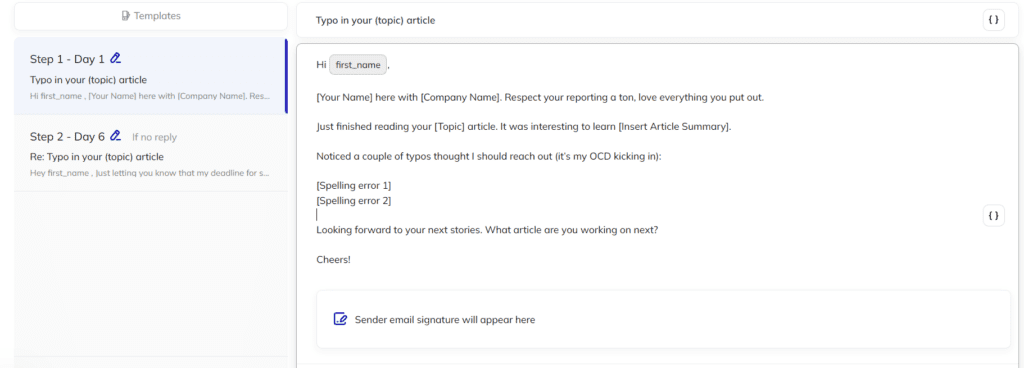
Let’s face it: No one—and I mean no one—wants to have typos on their content.
Especially if we’re talking about websites with high traffic or journalists who publish articles in high-authority publications, typos are even more important.
Of course, many of these large publications and blogs have an army of editors and proofreaders backing them up.
However, that doesn’t mean you can’t uncover such mistakes and point them out to the author of the post or article.
Author’s Tip: Most mistakes occur when the content piece or article is newly published. Thus, if you have bloggers or journalists you want to target, you have to act fast when they’ve published a new post or article.
When you identify 1-2 such mistakes in a prospect’s article, you can send them an honest and personalized message such as the following:
Subject: Typo in your (topic) article
Hi {first_name},
[Your Name] here with [Company Name]. Respect your reporting a ton, love everything you put out.
Just finished reading your [Topic] article. It was interesting to learn [Insert Article Summary].
Noticed a couple of typos thought I should reach out (it’s my OCD kicking in):
- [Spelling error 1]
- [Spelling error 2]
Looking forward to your next stories. What article are you working on next?
Cheers!
Why We Like It: It’s easy to implement and can help you build a relationship with your target journalist or blogger.
Ideal For: Building relationships—you won’t get results right away using this tactic.
What to Pay Attention to: This tactic is often overused, so don’t overdo it with pointing out typos and other mistakes to journalists or bloggers.
2) The “Infographic for Your Post V1” One

Similar to the example we mentioned earlier, this PR outreach template can help you pitch an infographic to a blogger or journalist.
It can be particularly effective if your infographic is relevant to your prospect’s beat, and if your message is well-written and non-self-promotional.
Just keep in mind that most journalists or bloggers won’t bother checking your infographic if they don’t believe there’s any actual value there.
So, the way you structure your message is essential here.
Here’s the body text for this template:
Subject: Infographic for your (topic) post
Hi {first_name},
Just finished reading your [Topic] article. Thanks for the awesome post! Shared with our PR team over here at [Your Company Name].
Loved the way you said [Insert Article Summary].
We’ve actually written a few in-depth articles about [Topic] in the past and our design team has put together a really neat infographic to go along with it!
Let me know if you want to take a look!
Why We Like It: It can be effective when the infographic is actually well-designed and contains genuinely valuable information.
Ideal For: Companies that have the capacity to source data or conduct studies by themselves and design beautiful infographics to accompany these.
What to Pay Attention to: You have to create something truly remarkable to get noticed.
3) The “Infographic for Your Post V2” One
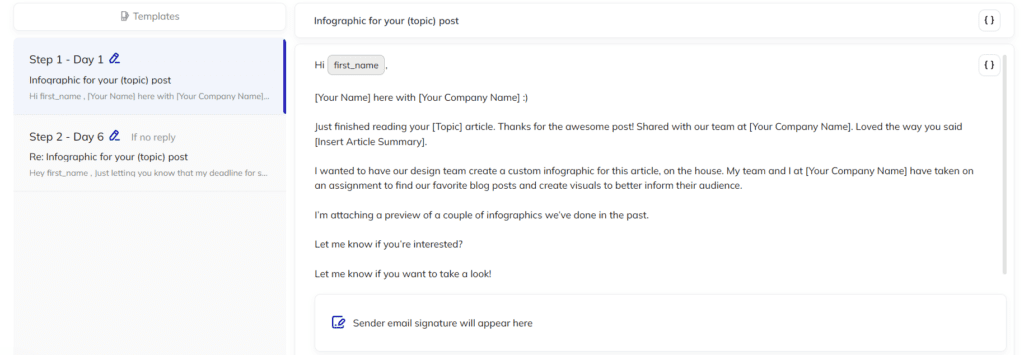
Here’s another way to pitch an infographic.
This may not have as direct an effect as the previous one, but results can be satisfying here as well.
Basically, with this template, you create the infographic only when you know that your prospect is interested in collaborating with you.
This means that if your pitch and overall approach is relevant, this template may work well for you.
Keep in mind that when journalists or bloggers collaborate with individuals or companies to cover a story or write a blog post, they want the end result to be as collaborative as possible.
Here’s the template our users are using:
Subject: Infographic for your (topic) post
Hi {first_name},
[Your Name] here with [Your Company Name] :)
Just finished reading your [Topic] article. Thanks for the awesome post! Shared with our team at [Your Company Name]. Loved the way you said [Insert Article Summary].
I wanted to have our design team create a custom infographic for this article, on the house. My team and I at [Your Company Name] have taken on an assignment to find our favorite blog posts and create visuals to better inform their audience.
I’m attaching a preview of a couple of infographics we’ve done in the past.
Let me know if you’re interested?
Why We Like It: You don’t actually have to create an infographic—you can demonstrate value by pitching infographics you’ve created in the past.
Ideal For: Companies that have the capacity to source data or conduct studies by themselves and design beautiful infographics to accompany them.
What to Pay Attention to: Your previous infographics must be truly remarkable (it would help if you’ve already gotten a couple of mentions in the past from journalists who your prospects know themselves).
4) The “Could You Take a Look at My Post?” One

This is the last one I have for you.
When you read an article (or blog post) and see that something is missing—something that you’ve mentioned in one of your posts, then this template comes in handy.
The only thing that you really have to pay attention to is that your pitch has to be really relevant for this template to work.
Don’t use this template if you’re not sure if what you’ve published can actually add value to the blog post or article in which you want to get featured.
Subject: Suggestion for your (topic) post
Hi {first_name},
I just finished reading your post on [Article Topic]. Loved the way you mentioned [Insert Article Summary].
However, I noticed it didn’t mention one main point: [Your Article’s Unique Point].
[Explain in 1-2 sentences what your article talks about].
Please feel free to take a look: [Your Article URL]
Let me know what you think?
Thanks!
Why We Like It: It works, especially if you know the topic you’re covering really well.
Ideal For: Companies that go really in-depth with their content.
What to Pay Attention to: You have to be absolutely sure that your content piece or resource can add value to the article or blog post in which you want to get featured.
Tools to Use for Your PR Outreach Strategy
The truth is that with all the tools that exist out there, it’s easy to get lost and feel overwhelmed by the variety of choice.
This is why I created this small list of four tools you’re going to need in order to start your own media outreach strategy.
Let’s get started.
1) Respona
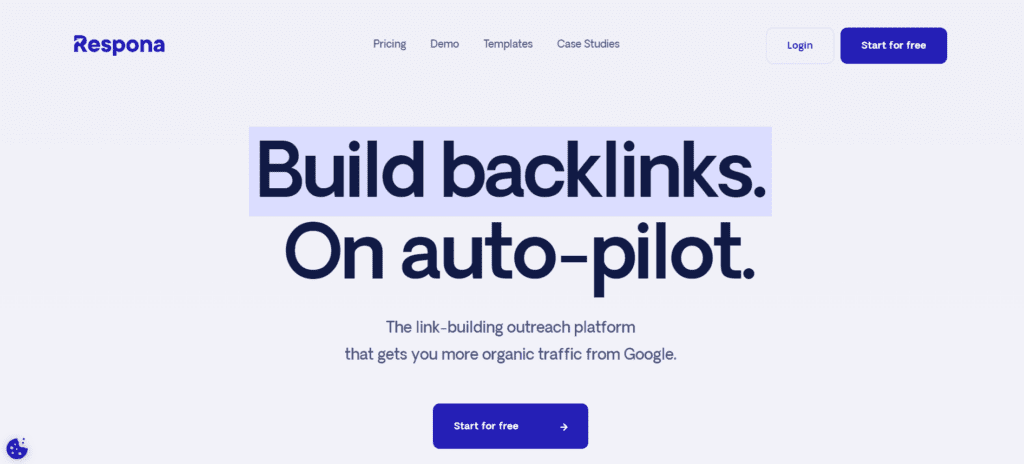
Respona is the first PR tool you need to launch a journalist outreach campaign.
It helps you discover opportunities, find their best email addresses, and reach out to them in a friendly and personalized way.
As we invest time and effort in getting to know what resonates most with our users and what they need to launch successful outreach campaigns, we constantly improve the product and add new, exciting features.
Sign up for a free 14-day trial (no credit card required) and see what Respona can do for you.
Website: Respona
Why We Like It: It allows you to create and send PR campaigns in minutes.
Pricing: Please visit Respona’s pricing page.
Ideal For: PR outreach and digital PR.
2) Ahrefs
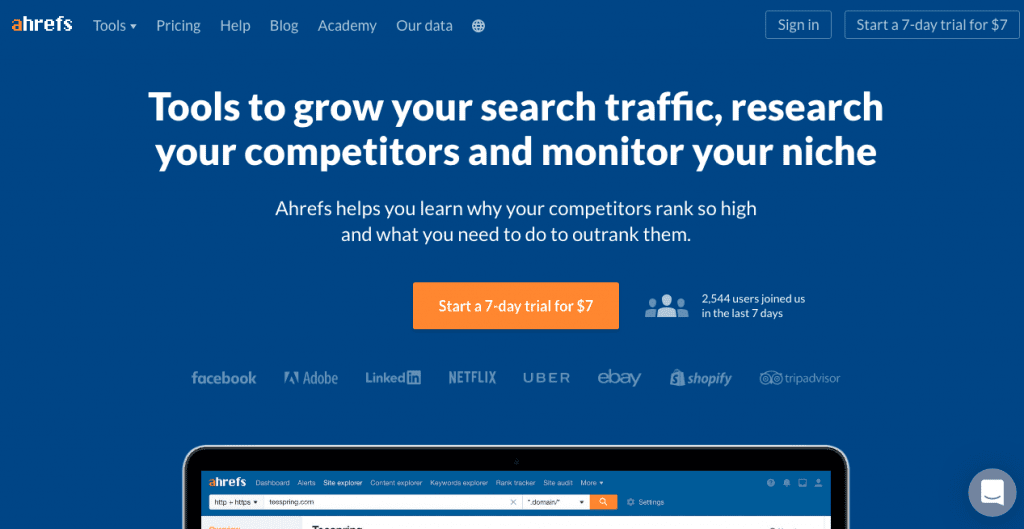
Ahrefs is a competitor analysis software tool for both “regular” and local SEO, and businesses of all sizes.
It can be particularly useful when you’re analyzing PR opportunities or trying to reverse engineer the strategies of your competitors on a PR, link building and content promotion level.
Feel free to give it a try with a 7-day trial for $7 and see what Ahrefs can do for you.
Website: Ahrefs
Why We Like It: It helps you find out what websites promote your competitors and uncover opportunities for PR outreach.
Pricing: Starts at $99 per month.
Ideal For: Content research and competitor analysis.
5) Prezly
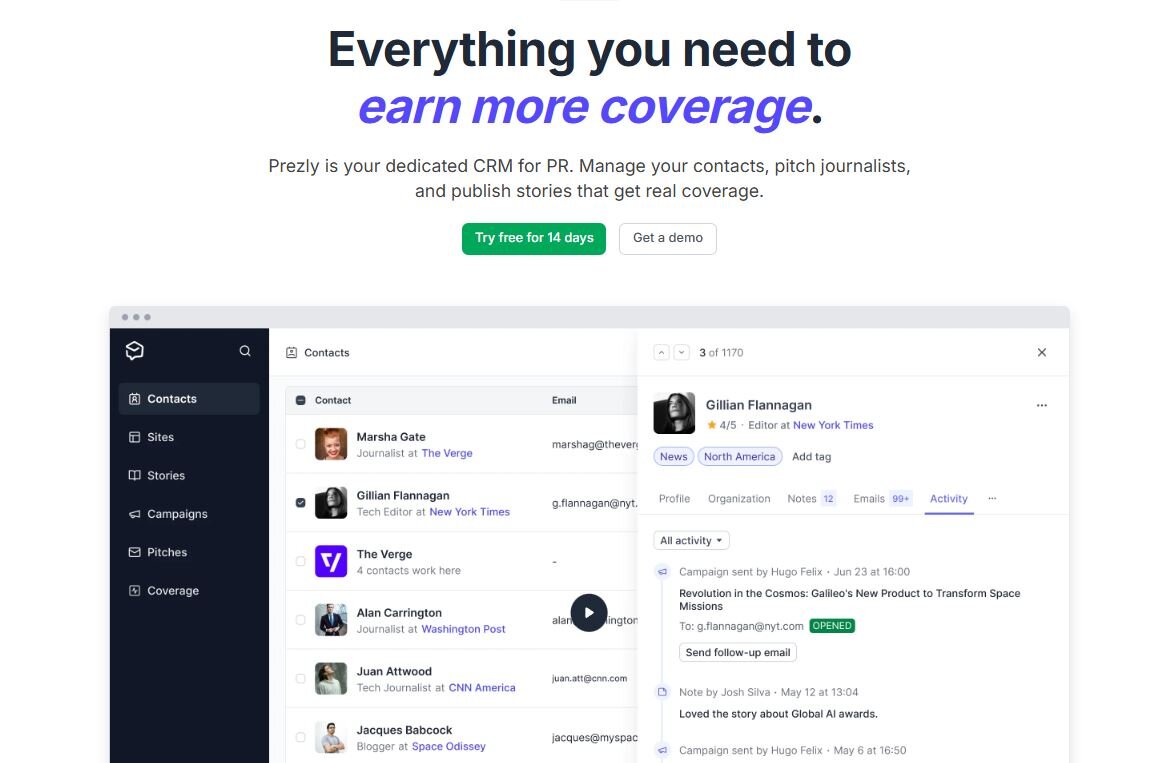
Prezly is an all-in-one PR software platform that streamlines the process of creating, publishing, and managing your media relations content.
With Prezly, you can design visually appealing, multimedia press releases that include images, videos, embeds, and more—no design or development skills required. Each release is published in your own branded newsroom, giving your content a permanent and professional online home.
What sets Prezly apart is its integrated CRM system. It allows you to organize and segment your media contacts into tailored lists, track engagement on your pitches, and measure performance over time. You’ll know who opened your emails, clicked your links, and interacted with your content—giving you the insights you need to optimize your campaigns.
From managing contact lists to publishing newsroom-ready content, Prezly provides an all-in-one dashboard to help you stay on top of your PR outreach campaigns.
Why We Like It: Combines newsroom publishing with contact management and analytics
Favorite Feature: Branded multimedia newsroom
Ideal For: Creating and publishing press releases / Managing media contacts / Measuring PR performance
Pricing: Starts at 40€/month
3) Exploding Topics

Exploding Topics is a new tool that was recently acquired by Backlinko’s Brian Dean.
What is Exploding Topics?
As Brian Dean puts it:
“How Exploding Topics works is that it monitors searches, conversations and shopping results around the web, and identifies topics that are taking off.”
So, this tool allows you to discover opportunities in terms of what’s being discussed right now and create content around those opportunities (when it makes sense for your business or website to do so, of course).
It does this by sending an email newsletter right into your inbox every Tuesday.
This means that you don’t have to login to the tool or visit the website to discover trending topics.
The best part?
It’s (still) free.
So go on and see what Trending Topics can do for you.
Website: Exploding Topics
Why We Like It: It sends trending topics right to your inbox.
Pricing: Free.
Ideal For: Discovering trending topics.
4) LinkedIn
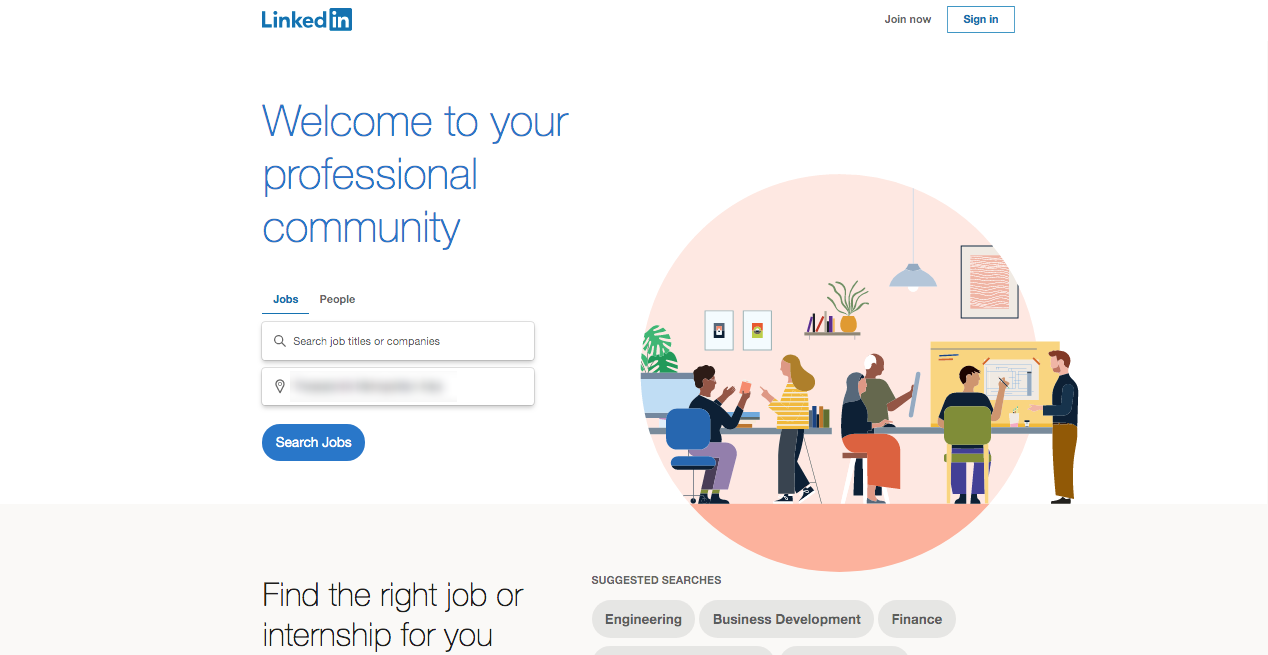
Everyone knows LinkedIn nowadays, and most people use it for sales or content promotion/distribution.
The popular social media network currently has over 575 million users from around the world.
LinkedIn is one of the best ways to connect with journalists and bloggers before you pitch them an idea or promote one of your content pieces.
This is why Respona gives you the LinkedIn profile of the contacts you’re about to reach out to—so that you can establish a relationship before sending a cold email pitch.
Feel free to check it out and try to be genuine with your interactions.
Website: LinkedIn
Why We Like It: It allows you to connect with anyone and interact with their content before pitching to them.
Pricing: Free/paid options available.
Ideal For: Building relationships with journalists before sending them a pitch.
Link building cheat sheet
Wrapping Up
So there you have it.
You now know how press pitching works and how you can approach your target journalists with style.
Remember: Journalists have seen pretty much every pitch you can imagine.
This is why PR outreach is now more difficult than it used to be.
Even experienced PR professionals and PR firms are having a hard time with their PR pitches nowadays.
However, the truth is that all these people—journalists, bloggers, influencers—are constantly on the lookout for new and interesting content online.
What you need to do is serve that content in a unique and straightforward way.
In other words, it doesn’t really matter if you think you’ve created the perfect pitch.
You also have to experiment with your outreach efforts, test new things and be relevant to get a positive reply.
Now, I’d like to hear from you:
What is your pitching process? How do you form media relations and what specific tactics are you using in your PR campaigns?
Let me know by leaving a comment below!







